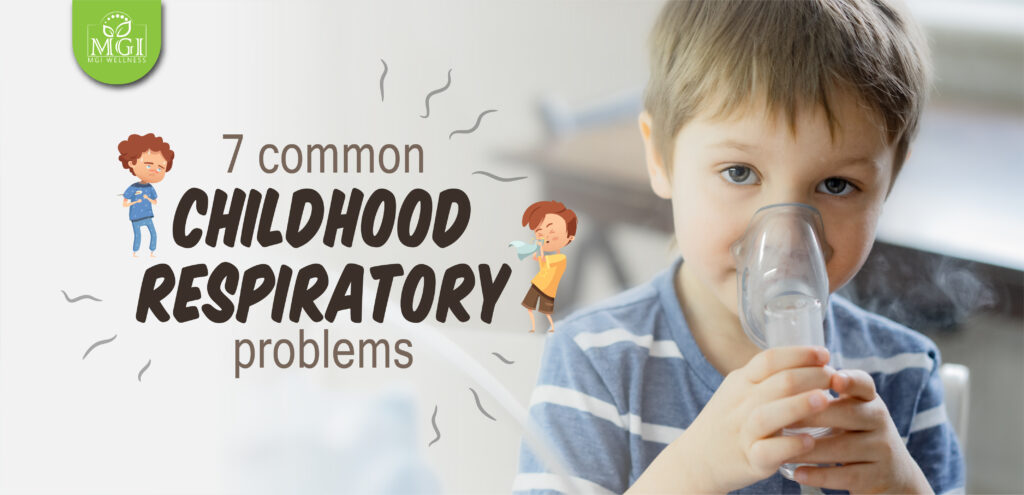Wellness
The common childhood respiratory problems
Respiratory problems among children are super common. Our kids are frequently exposed to germs that can potentially cause illness. Anyone can get infected, but infants and kids are the most vulnerable due to their weaker immune systems. Here is the list of 7 most common childhood respiratory problems that may impact your child at some point:-
-
Pneumonia (Lungs inflammation)
Pneumonia is one of the top five causes of childhood death in Malaysia, according to the Department of Statistics. Pneumonia is a lung infection that causes the air sacs (alveoli) in the lungs to fill up with fluid or pus, making it difficult to breathe in enough oxygen for the body. Globally, around 1.4 million children under five years of age die every year because of pneumonia. The signs and symptoms of pneumonia may include:
- Cough(which may produce greenish, yellow or even bloody mucus)
- Fever, sweating and shaking chills
- Shortness of breath
- Rapid, shallow breathing
- Sharp or stabbing chest pain that gets worse when you breathe deeply or cough
- Loss of appetite, low energy, and fatigue
- Nausea and vomiting(especially in children)
- Confusion(especially in the elderly)
-
Influenza (Flu)
Influenza is a virus that can cause five to seven days of high fevers, muscle aches, fatigue, cough and runny nose. Influenza can be dangerous especially in young children. Kids’ fevers tend to be higher than in adults, and their digestive symptoms are typically worse too. Vaccination can greatly reduce the risk of contracting the illness or lessen the symptoms while getting the flu. The signs and symptoms of the flu may include:
- Fever
- Cough
- Sore throat
- Runny or stuffy nose
- Muscle or body aches
- Headaches
- Fatigue
- May experience vomiting and diarrhea(this is more common in children than adults)
-
Common Cold (Upper respiratory infection)
The common cold is a viral infection of your nose and throat (upper respiratory tract). Many types of viruses can cause a common cold but it is typically less severe than influenza and have a lower risk of causing secondary pneumonia. The signs and symptoms of common cold may include:
- Runny or stuffy nose
- Sore throat
- Cough
- Congestion
- Slight body aches or a mild headache
- Sneezing
- Low-grade fever
- Generally feeling unwell
-
Asthma
Asthma attacks can be triggered by a number of factors, such as inhaling dust or pollen or exposure to an allergen such as pet dander. Asthma can put children at higher risk of bronchitis or pneumonia. The signs and symptoms of asthma may include:
- Coughing
- Chest tightness or pressure
- Shortness of breath or difficulty breathing
- Wheezing or whistling when exhaling
-
Sinusitis
Also called a sinus infection, sinusitis is an inflammation or swelling of the tissue that lines the sinuses.
It is often accompanied by a cold or the flu. The signs and symptoms of sinus may include:
- Sinus pressure behind the eyes and the cheeks
- A runny, stuffy nose that lasts more than a week
- Headache
- Fever
- Cough
- Bad breath
- Thick yellow or green mucus draining from your nose or down the back of your throat (postnasal drip)
- Fatigue
- Decreased sense of smell
-
Bronchitis(Bronchi inflammation)
Bronchitis is inflammation of the bronchi or the large breathing tubes in the lungs. It’s usually caused by a virus and may develop after having had a cold or the flu. Sometimes asthma can be mistaken for bronchitis, so when in doubt, check with your medical specialist. Treatment usually focuses on easing symptoms. Children who have bronchitis may experience a constant coughs that lingers for three to four weeks. The signs and symptoms of bronchitis may include:
- Runny nose.
- Chest pain and congestion.
- Fever and chills.
- Overall feeling of malaise or tiredness.
- Sore throat.
-
Strep Throat
Strep throat is quite common in children, there are up to 3 in 10 children with a sore throat will have strep throat. It is an infection in the throat and tonsils caused by bacteria called group A Streptococcus (group A strep). Signs and symptoms of strep throat are very similar to an ordinary sore throat, but in general strep throat has:
- Sore throat that can start very quickly
- Pain when swallowing
- Fever
- Red and swollen tonsils, sometimes with white patches or streaks of pus
- Tiny, red spots on the roof of the mouth (the soft or hard palate)
- Swollen lymph nodes in the front of the neck
- Other symptoms may include: headache, stomach pain, nausea, or vomiting (especially in children)
The most important approach to respiratory illnesses is prevention and boost up their immune system to avoid infection. Know the signs and symptoms, and seek help from your medical specialist for any symptoms that linger or seem to get worse over time.
Reference:
- Statistics on Causes of Death, Malaysia, 2020
- Allen S. et al. Association between antioxidant vitamins and asthma outcome measures: systematic review and meta-analysis. Thorax. 2009, 64(7):610-9
- Brooks. Zinc for severe pneumonia in very young children: double-blind placebo-controlled trial. Lancet. 2004, 363(9422): 1683.
- Gilliland FD. et al. Children’s lung function and antioxidant vitamin, fruit, juice, and vegetable intake. Am J Epidemiol. 2003, 158(6):576-84.


Really enjoyed this blog article.Really thank you! Cool.
I’ve been surfing online more than 4 hours today, yet I never found any interesting article
like yours. It’s pretty worth enough for me. In my view, if all webmasters and bloggers made good
content as you did, the internet will be much more useful than ever before.
Really enjoyed this post.Really thank you! Keep writing. makaberzux
Really enjoyed this post.Really thank you! Keep writing. makaberzux
Really enjoyed this post.Really thank you! Keep writing. makaberzux
Really enjoyed this post.Really thank you! Keep writing.
Really enjoyed this post.Really thank you! Keep writing. makaberzux
Wow, amazing blog layout! How long have you been blogging for? you make blogging look easy. The overall look of your web site is magnificent, as well as the content!
Wohh precisely what I was searching for, regards for putting up.
Definitely, what a great blog and revealing posts, I definitely will bookmark your site. Best Regards!
Thanks-a-mundo for the post.Really thank you! Awesome.
As a Newbie, I am continuously exploring online for articles that can be of assistance to me.
A round of applause for your article. Much thanks again.